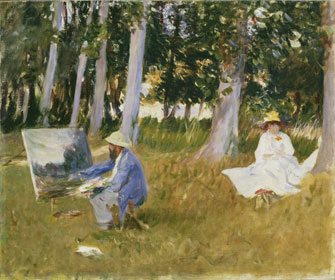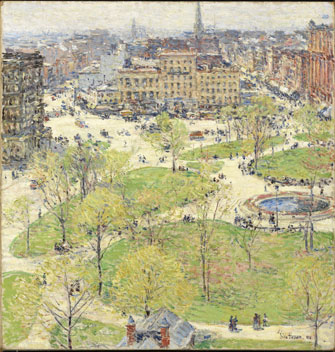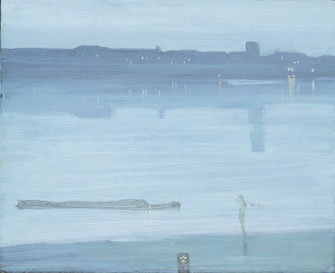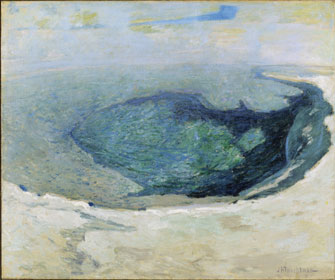American Impressionists
Bring It All Back Home

“Claude Monet Painting by the Edge of a Wood” (1885), by John Singer Sargent. © Tate, London, 2014
Anyone planning a trip to Monet’s garden in Giverny – a lush riot of color at this time of year – should also count on paying a visit to the nearby Musée des Impressionnismes. Worth a visit for its clean, modern architecture and especially for its own starkly modern garden, a pleasing contrast to the profusion of Monet’s, it is currently holding a fine show comparing American Impressionists with their French counterparts, “L’Impressionnisme et les Américains.”
The exhibition starts strongly with a sublime example of John Singer Sargent’s talents as a portraitist, the painting “Lady Agnew of Lochnaw” (1892), whose subject, with a wide lilac sash cinched around her narrow waist, gazes at the viewer with a knowing look and a Mona Lisa smile.
Although not strictly an Impressionist, Sargent often painted in the Impressionist style and made pilgrimages to see the master, his friend Monet, in Giverny. His “Claude Monet Painting by the Edge of a Wood” (1885; pictured above), included in the exhibition along with a number of other paintings by Sargent, shows Monet at work while his wife, dressed in white, sits on the grass reading.
Sargent was one of many American painters (although he himself lived most of his life in Europe) who were inspired by and learned from the French Impressionists, often going straight to the source in Giverny. In fact, so many American artists gathered there that Monet eventually took his distance from most of them. A leading example is Theodore Robinson (1852-96), who moved in next door to Monet in Giverny and became a good friend of his. Some of Robinson’s works, among them “Blossoms at Giverny” (1891-92), a view of a woman and child seen from above in a flowering orchard, are included in the exhibition.
After showing us American Impressionists painting in France and comparing them with the work of their French counterparts – one notable juxtaposition is of Monet’s paintings of haystacks, captured at different times of day and in different light conditions, with a similar series by John Leslie Breck (1860-99), also painted in Giverny (Breck’s, while admirable, do not quite rise to the level of the master’s) – the show follows the Americans back to the United States, where many of them continued to paint in the Impressionist style.
Somehow it seems odd to see typical American scenes painted impressionistically, but there are many lovely works here, among them Childe Hassam’s “Union Square in Spring”

“Union Square in Spring” (1896), by Childe Hassam. © Smith College Museum of Art
(1896), so reminiscent of Gustave Caillebotte’s “The Boulevard Viewed from Above” (1880), with its cityscape seen from a window on high, but in this case with the imposing buildings of New York City as a backdrop.
In the exhibition’s final room, we see how James Abbott McNeill Whistler’s beautifully

“Nocturne: Blue and Silver – Chelsea” (1871), by James Abbott McNeill Whistler. © Tate, London, 2014
ethereal paintings like “Nocturne: Blue and Silver – Chelsea” (1871) anticipated Impressionism and influenced American Impressionists, notably John Henry

“Emerald Pool, Yellowstone”(c. 1895), by John Henry Twachtman.
Twachtman (1853-1902), whose atmospheric “Emerald Pool, Yellowstone” (1895) shows combined inspiration from the work of Whistler and the French Impressionists.
This is an illuminating exhibition, both literally and figuratively, and highly recommended during a day trip to Giverny combined with a visit to Monet’s gardens (a specially priced ticket for both is available). While you are at the museum, have a drink or a bite to eat on the terrace of its pleasant café, and make sure you walk through the gardens, just beyond which is the actual poppy field so famously painted by Monet, still studded with the fragile bright-red flowers.
Musée des Impressionnismes Giverny: 99, rue Claude Monet, Giverny. Take train from Gare Saint Lazare to Vernon, then shuttlebus (outside train station). Tel: 02 32 51 94 65. Open daily, 10am-6pm. Admission: €7 (combined ticket with Monet’s house and garden: €16.50). www.mdig.fr
Click here to read all of this week’s new articles on the Paris Update home page.
Reader Anika Savage writes: “The portrait by Sargent stands out for me in that exhibit. Sargeant was popular during his lifetime and well after his death. However, in the 1930s he fell out of style and was considered old-fashioned. His immense talent is now recognized, and he’s back ‘in.’ Early in his career, he decided to become a portrait painter, the most reliable way to make a living as an artist, and he felt he would have to support his parents and sisters. Later in his career, desiring to paint other subjects, he declared, ‘No more mugs’.”
Reader Reaction: Click here to respond to this article (your response may be published on this page and is subject to editing).
Support Paris Update by ordering books from Paris Update’s Amazon store at no extra cost. Click on your preferred Amazon location: U.K., France, U.S.
© 2014 Paris Update
Favorite
